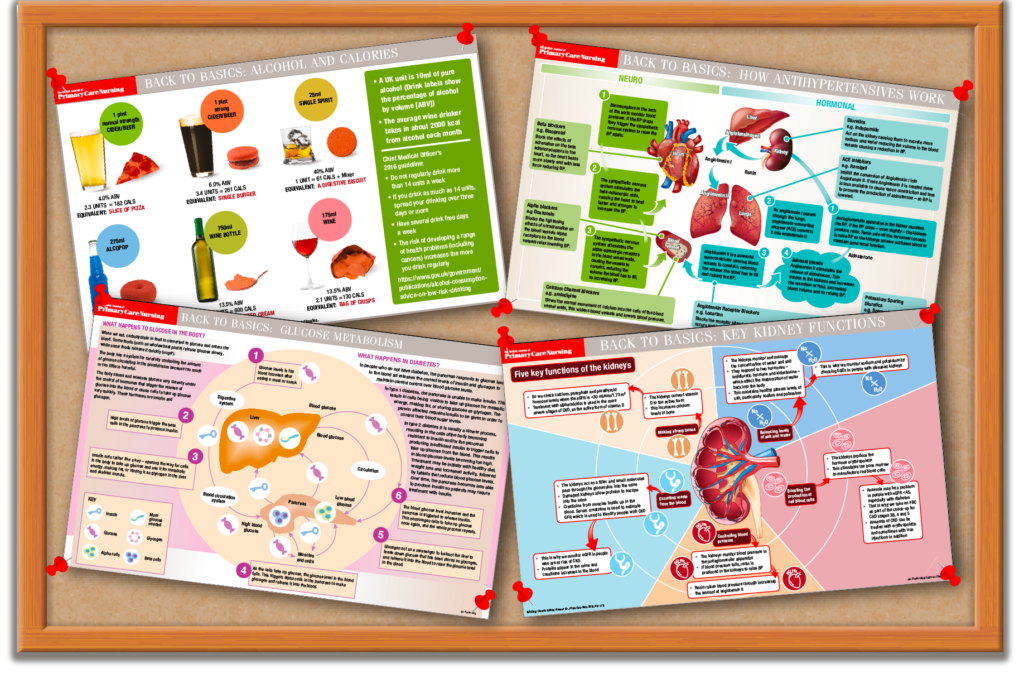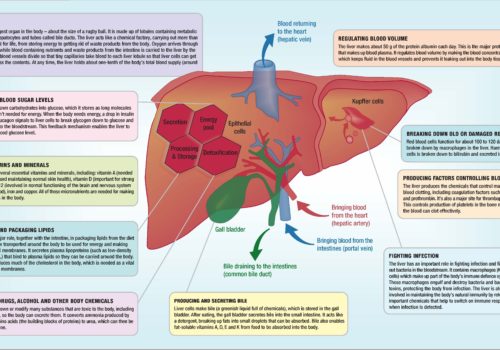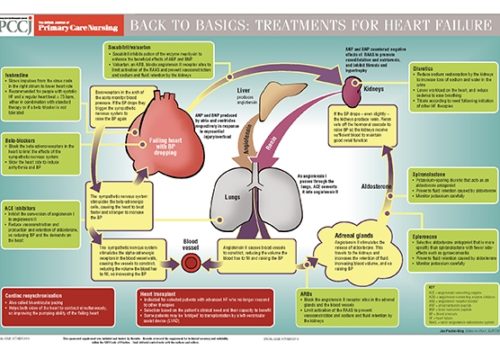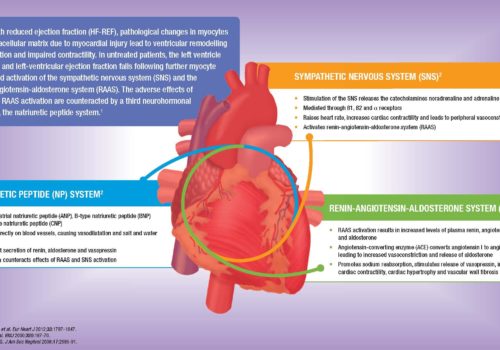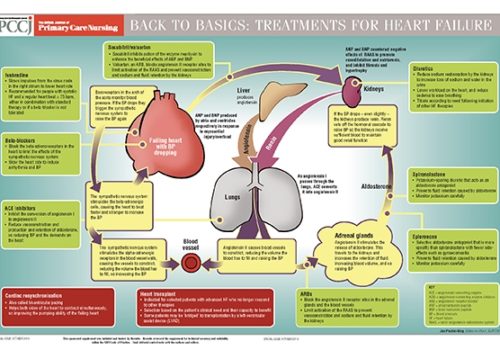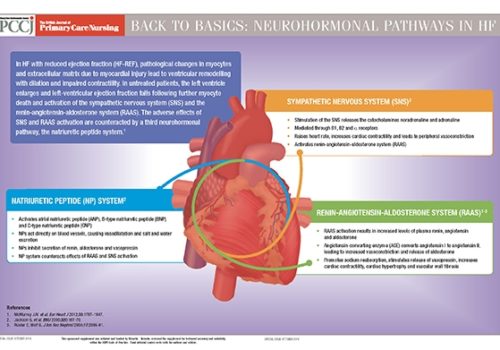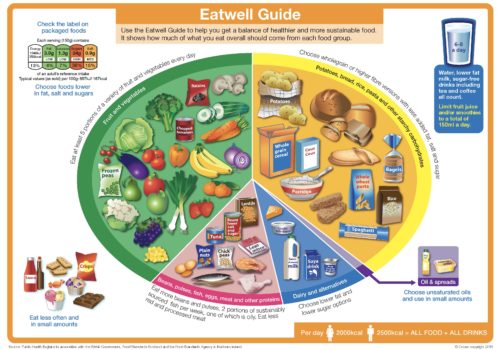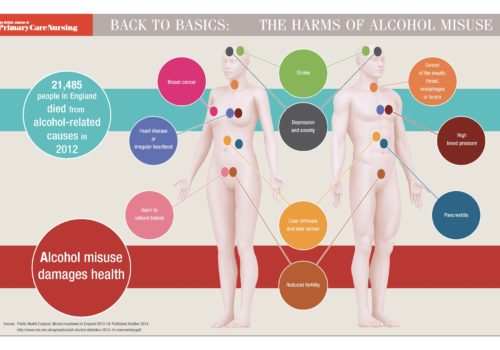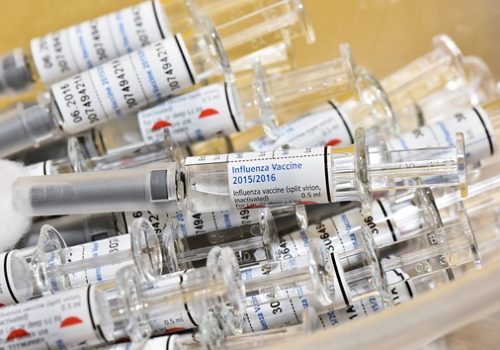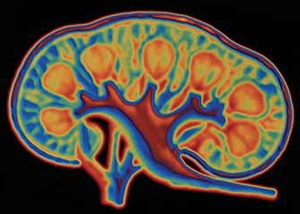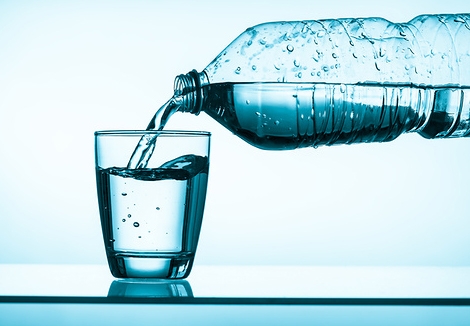This Back to Basics feature is a wallchart describing the functions of a healthy liver – the largest organ in the body. It carries out more than 500 tasks essential for life. This wallchart accompanies details on the new NICE guideline on non-alcoholic fatty liver disease.
Back to Basics: Heart failure treatments – mechanisms of action
A number of drug classes are used in the treatment of patients with heart failure. This illustrated Back to Basics poster describes the various drugs and their mechanisms of action to give health care professionals and their patients a greater understanding of heart failure management and where sacubitril/valsartan fits into the picture.
Back to Basics: The neurohormonal system in the pathophysiology of heart failure
This useful Back to Basics poster describes the damaging changes that take place in three key body systems when HF with reduced ejection fraction is left untreated. The sympathetic nervous system, the renin-angiotensin-aldosterone system and the natriuretic peptide system all undergo significant pathophysiological changes as HF progresses.
Back to Basics: Heart failure treatments: mechanisms of action
A number of drug classes are used in the treatment of patients with heart failure. This illustrated Back to Basics poster describes the various drugs and their mechanisms of action to give health care professionals and their patients a greater understanding of heart failure management and where sacubitril/valsartan fits into the picture.
Back to Basics: The neurohormonal system in the pathophysiology of heart failure
This useful Back to Basics poster describes the damaging changes that take place in three key body systems when HF with reduced ejection fraction is left untreated. The sympathetic nervous system, the renin-angiotensin-aldosterone system and the natriuretic peptide system all undergo significant pathophysiological changes as HF progresses.
Back to Basics: The eatwell guide
This month’s Back to Basics feature is a wallchart showing the new government Eatwell Guide to help your patients understand how to eat a healthy and balanced diet. You may also be interested in visiting the Eatwell page on the NHS Choices website. This includes useful healthy eating tools such as a calorie checker and BMI calculator.
Back to Basics: NHS Health Check – interpreting results
This month’s Back to Basics feature is a free wallchart to aid interpretation of the NHS Health Check results. Use this information with last month’s Back to Basics NHS Health Check chart to raise your patients’ awareness of cardiovascular risk factors and to determine the best lifestyle and medical approaches for each individual.
Back to Basics: The harms of alcohol misuse
This month’s Back to Basics feature is a wallchart describing the multiple harms of alcohol misuse in men and women. This could be used during discussions with patients at risk of excess alcohol consumption.
Back to Basics: Free NHS Health Check results sheet
Use this free downloadable results sheet to help you and your patients make the most of the NHS Health Check. In addition to recording all the test results, the sheet features a list of personal goals and healthy lifestyle tips for your patient to increase motivation.
Back to Basics: Flu vaccinations 2015-2016
Colder days and longer nights are reminders that the annual winter flu season is here. It’s important to offer flu vaccination to vulnerable patients (young children, the elderly and people with underlying health conditions) to help prevent serious complications. This Back to Basics will help you to make sure that your practice is offering the right flu vaccine.
Back to Basics: CKD – risk assessment and monitoring
Chronic kidney disease (CKD) is now classified using a combination of estimated glomerular filtration rate (eGFR) and proteinuria measured by albumin:creatinine ratio (ACR). The aim is to more accurately define each patient’s risk of cardiovascular disease and worsening CKD, and to ensure that patients are monitored appropriately.
Back to Basics: Hydration
Good hydration is essential for health, especially for people who may not feel thirsty because of ageing or illness. Maintaining good levels of hydration can prevent or help in treating low blood pressure, urinary infections and constipation. It’s so easy to assess hydration status – this useful guide will help.

